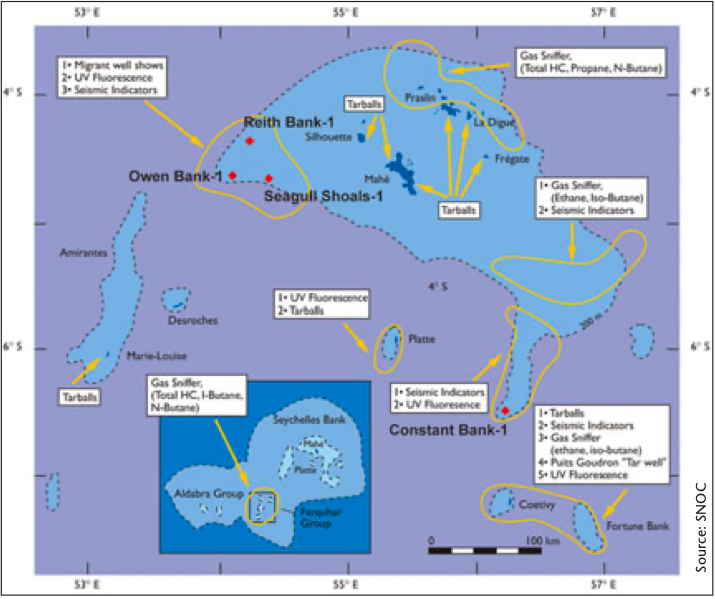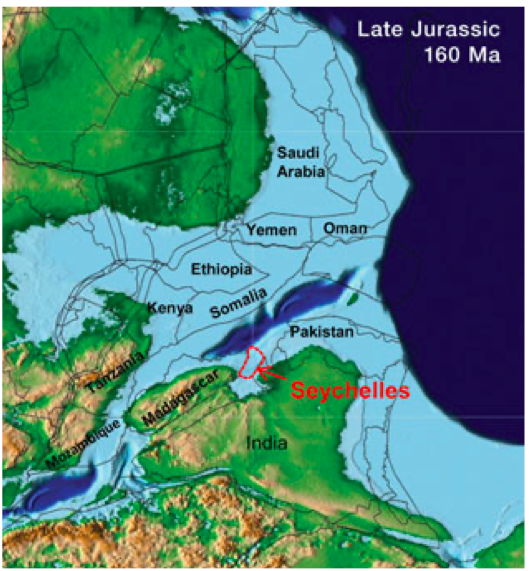
Seychelles: New insights revealed
The Seychelles Exclusive Economic Zone covers over 1.3 million km2 and contains more than 100 islands, the largest composed of Precambrian granites and rising over 700m above sea level. It was these granitic islands, indicating the presence of a microcontinent, which drew Mobil to conduct the first exploration seismic survey in the area in the early 1970s.
In the early 1980s Amoco drilled three wells which confirmed that the Seychelles contains highly prospective Triassic, Jurassic and Cretaceous stratigraphy analogous to productive sections in East Africa and Madagascar. In Owen Bank-1 over 1,500m of a Middle to Late Jurassic syn-rift shaledominated sequence was penetrated with good source and seal potential. Reith Bank-1 found 2,000m of a continental Middle Triassic to Early Jurassic Karoo Formation section with good reservoir quality sands and interbedded shales, while Seagull Shoals-1 penetrated a similarly attractive Karoo section. Oil and gas shows provide excellent evidence of a working petroleum system, and the new Seychelles MC2D suggests the wells may not have tested valid closures, with considerable updip potential recognised.
In a subsequent exploration phase, Enterprise Oil drilled Constant Bank-1 in 1995, reaching TD at 3,437m in Paleocene volcanics. The new data provides significantly improved imaging of the sub-basalt section near Constant Bank and potential for a large untested deep structure. Current operators, WHL Energy and Afren are actively exploring their respective acreage and the next round of exploration drilling is planned for 2012/2013.
Petroleum system
Evident The Seychelles was originally part of the Gondwana Supercontinent, nestled between Madagascar, India, Pakistan and Somalia. As a result, the Seychelles has close similarities to geological elements of these areas.
Three phases of rifting have impacted the Seychelles microcontinent, eventually leading to its present isolated position. These are the Mid-Early Jurassic separation of Madagascar, Seychelles and India from Africa along the Karoo rift zone; Middle Cretaceous rifting related to the separation of Seychelles and Madagascar and resulting in the >3,000m Mascarene Basin section, as shown on the seismic section on page 58; and Late Cretaceous rifting of India from the Seychelles.
Airborne geochemical survey data, tar ball occurrences, seismic indi cators of gas and hydrocarbon leakage and source rock data from the Amoco wells all support the presence of an active petroleum system in the Seychelles.
The tar balls have been extensively analysed, and researchers have interpreted a number of different local source rock families (Plummer, 1996). These include a locally developed Middle Jurassic open marine anoxic carbonate source rock, a Campanian or Maastrichtian – Paleocene paralic oil-prone predominantly clastic shale source, with carbonate influence, and a predominantly tropical terrestrial source possibly developed in a Middle to Late Cretaceous clastic delta.

Seychellois stratigraphy
The Late Permian to Early Jurassic Karoo section consists of non-marine continental sands and shales, faulted against or onlapping the Precambrian granitic basement. A regionally recognised prolific lacustrine or restricted marine source rock is expected at the Permo-Triassic boundary.
The Sakemena Shale in Madagascar is the source for the billion barrel heavy oil/tar sand deposits of the Bemolanga and Tsimiroro fields, while the equivalent age Bokh Shale sources the multi-Tcf gas condensate Calub Field in Ethiopia. Rifting of Madagascar and the Seychelles from East Africa resulted in a thick Middle to Late Jurassic rift section in the region. Interbedded shales, oolitic limestone and sandstones were deposited in shelf settings, with deeper marine shales and carbonates present in basinal locations with potential turbidite sands development.
The Middle Jurassic Bemaraha Formation in Madagascar contains anoxic marine carbonate and shale with excellent source potential and equivalent age formations in Tanzania and Mozambique are also recognised as high quality source rocks. Paleogeographic reconstructions show the Seychelles to be on structural and depositional trend in the Middle Jurassic and similar excellent quality source rocks are expected, which are likely to be mature for present day oil generation in the basinal and deepwater areas surrounding the banks and plateaus.
The opening of the Mascarene Basin with sea floor spreading between Madagascar and the Seychelles was a major structural event and resulted in up to 5,000m of Cretaceous sediment in areas to the south and south-east of the Seychelles, including along the Mascarene Plateau. River systems draining vast areas of India and Pakistan provide an abundant sediment source. Potential reservoir facies include shoreface and incised valley fill sands, with potential for turbidite sands in more distal locations.
Cretaceous source rocks potential is recognised from regional anoxic events (i.e. Turonian) and modelling indicates significant areas where prospective source units will be currently in the oil window. Some Maastrichtian age volcanics were intersected in the Amoco wells, with clearly identifiable thinning onto structural highs on seismic data. With the separation of the Seychelles from the Indian sub-continent in the Palaeocene, the region became removed from major clastic sediment source, and the Tertiary shelf section comprises pre-dominantly carbonates with some well-developed shallow marine sands eroded from exposed granites. Mudstone and finegrained carbonate are expected in the deepwater setting off the main bank areas and there is seismic evidence for some turbidite sands development. The Palaeocene section consists of localised volcanics onlapping onto the Seychelles Plateau.
Several major plays
A number of plays have been identified in the Seychelles area. These include the Triassic and Early Jurassic Karoo fault block play, which comprises well developed non-marine sands sealed by Middle Jurassic–Early Cretaceous shales and fine-grained carbonates or intra-formational Karoo shales. Source is provided by Karoo shales or the interpreted regional Middle Jurassic carbonate enriched anoxic source rocks.
Structural traps include large rotated 3-way dip fault blocks and horst features with closures in excess of 100 km2 identified on the new Seychelles MC2D seismic. The Middle to Late Cretaceous Mascarene Basin play consists of shallow marine and deepwater turbidite sandstone reservoirs sealed by marine shales, partially underlying Late Cretaceous and Paleocene volcanics. Sources are Jurassic oil prone carbonates and shales or Cretaceous anoxic shales. The seismic line on page 58 shows the Cretaceous section to have an attractive seismic character with both stratigraphic traps (pinchout and onlap) and structural traps (inversion, faulted and drape features) evident.

Madagascar/Seychelles and regional marine source rock development.
The Tertiary carbonate play involves Tertiary reef build ups or oolitic shoals sealed by fine grained carbonates and marls with charge from mature Jurassic and Cretaceous source rocks. Additional plays are provided by Middle Jurassic oolitic limestone, Tertiary turbidites in deepwater settings, and possible fractured granitic basement and fractured volcanic targets.
The Seychelles is entering an exciting exploration phase. Recent success elsewhere in East Africa has focused industry attention on the region and the Seychelles Government provides a highly supportive environment for new entrants into the country. With a number of attractive plays, large untested structures and now 19,600 km of high quality MC2D data, the key elements are in place for exploration success.
References
Plummer, P.S., Origin of Beach-Stranded Tars from Source Rocks Indigenous to Seychelles. AAPG Bulletin, V. 80, No. 3 (March 1996), P. 323–339.
Rayer F. G., Toit S.R., and Slind O.L., Hydrocarbon potential of the East Africa continental margin from Somalia to South Africa, Oil & Gas Journal 1999.




